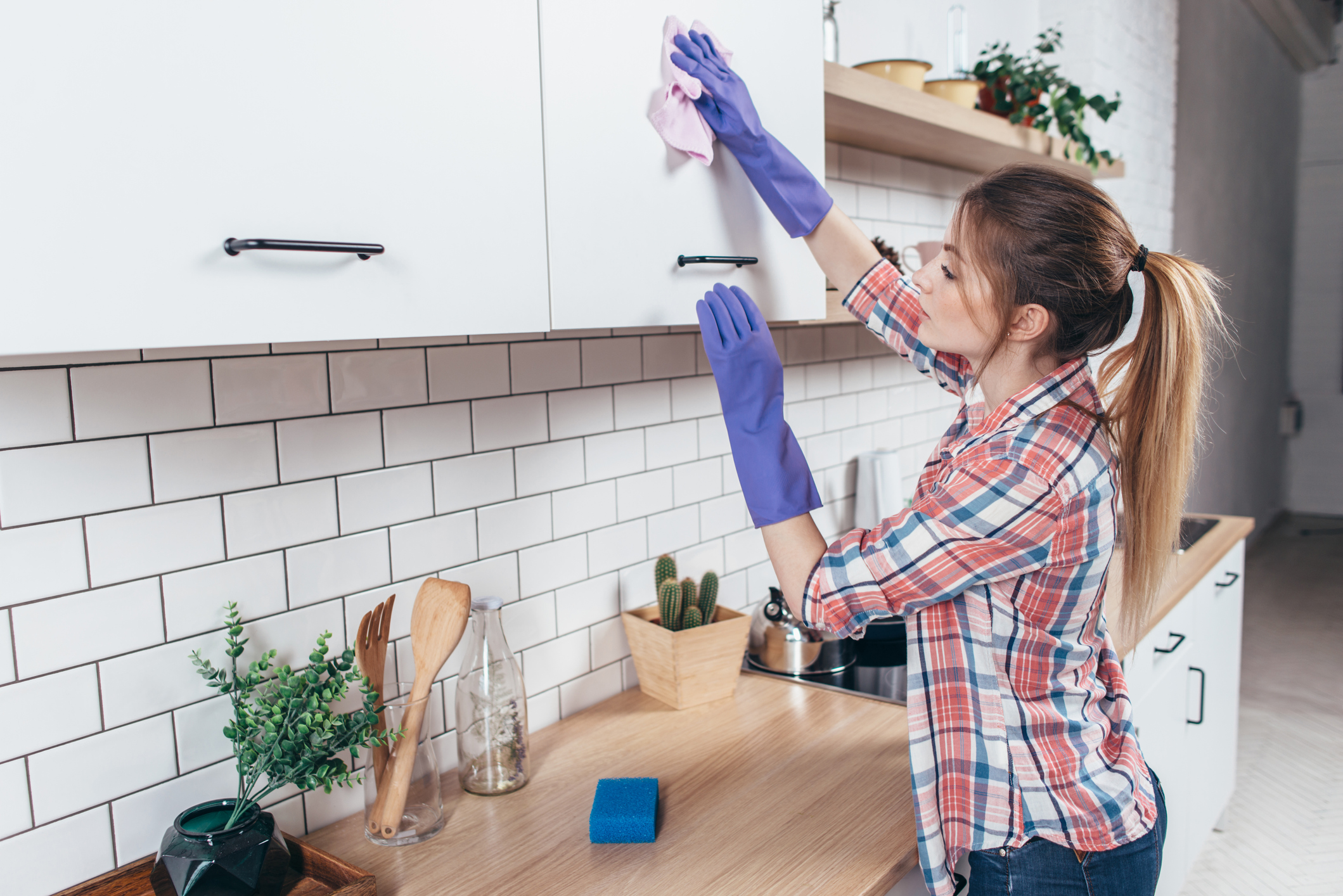The Science Behind Using Oil for Cleaning Kitchen Cabinets

Cleaning kitchen cabinets with oil may seem counterintuitive, but it’s a method that has been used for years. The science behind this technique lies in the properties of oil, which make it an effective cleaning agent for greasy surfaces.
The Properties of Oil for Cleaning, Cleaning kitchen cabinets with oil
Oil’s effectiveness in cleaning greasy surfaces stems from its ability to dissolve and lift away grease and grime. Oil molecules are non-polar, meaning they don’t have a positive or negative charge. This makes them attracted to other non-polar molecules, such as those found in grease and oil.
When oil comes into contact with a greasy surface, its molecules surround and encapsulate the grease molecules, effectively lifting them away from the surface. This process is similar to how soap works, except that oil is more effective at dissolving grease due to its non-polar nature.
Types of Oil for Cleaning Kitchen Cabinets
While any oil can be used to clean greasy surfaces, some types are more suitable than others. Here’s a breakdown of the most commonly used oils for cleaning kitchen cabinets:
- Mineral Oil: This oil is a highly refined petroleum product that is odorless and tasteless. It is a popular choice for cleaning kitchen cabinets because it is non-toxic and safe for food contact. Mineral oil is also very effective at dissolving grease and leaving a shiny finish.
- Olive Oil: This oil is a natural product that is extracted from olives. It is a good choice for cleaning kitchen cabinets because it is biodegradable and has a pleasant scent. However, olive oil can leave a residue if not properly wiped away, so it’s essential to use a clean cloth and wipe the surface thoroughly.
- Coconut Oil: This oil is extracted from coconuts and is known for its antimicrobial properties. It is a good choice for cleaning kitchen cabinets because it is biodegradable and can help to sanitize the surface. However, coconut oil can solidify at room temperature, so it may need to be warmed slightly before use.
Benefits and Drawbacks of Using Oil for Cleaning
Using oil to clean kitchen cabinets has its advantages and disadvantages compared to other cleaning methods:
- Benefits:
- Effective Grease Removal: Oil is highly effective at dissolving and lifting away grease, making it ideal for cleaning greasy kitchen cabinets.
- Safe for Food Contact: Most oils used for cleaning are non-toxic and safe for food contact, making them a good choice for cleaning surfaces that come into contact with food.
- Leaves a Shiny Finish: Oil can leave a shiny finish on kitchen cabinets, making them look clean and polished.
- Drawbacks:
- Can Leave a Residue: If not properly wiped away, oil can leave a residue on kitchen cabinets, making them look greasy and attracting dust and dirt.
- Not Suitable for All Surfaces: Oil is not suitable for cleaning all types of surfaces, such as painted cabinets or cabinets with delicate finishes.
- Can Be Difficult to Remove: Oil can be difficult to remove from surfaces, especially if it is left to dry.
Step-by-Step Guide to Cleaning Kitchen Cabinets with Oil

Cleaning kitchen cabinets with oil is a simple and effective method that can leave your cabinets looking shiny and new. Oil can help to remove grease, grime, and fingerprints, while also adding a protective layer to the wood.
Preparing the Cabinets
Before applying oil to your cabinets, it’s important to prepare them properly. This will ensure that the oil can penetrate the wood effectively and that you achieve the best possible results.
- Remove Loose Dirt and Debris: Start by removing any loose dirt, debris, or food particles from your cabinets using a dry cloth or a vacuum cleaner with a brush attachment.
- Wipe Down with a Damp Cloth: Next, wipe down the cabinets with a damp cloth to remove any remaining dust or grime. Make sure to wring out the cloth thoroughly to avoid soaking the wood.
Applying the Oil
Once the cabinets are clean and dry, you can start applying the oil.
- Choose the Right Oil: For cleaning kitchen cabinets, mineral oil or olive oil are good choices. Mineral oil is a more neutral option, while olive oil can leave a slight scent. Avoid using vegetable oil, as it can attract dust and dirt.
- Apply the Oil to a Soft Cloth: Pour a small amount of oil onto a soft cloth. You don’t need to use a lot of oil, as a little goes a long way.
- Rub the Oil into the Wood: Gently rub the oil into the wood, working in small sections. Be sure to cover all surfaces of the cabinets, including the doors, sides, and shelves.
- Wipe Away Excess Oil: After applying the oil, use a clean, dry cloth to wipe away any excess. This will help to prevent the oil from becoming sticky or attracting dust.
Materials and Tools
Here is a table outlining the necessary materials and tools for cleaning your kitchen cabinets with oil:
| Material/Tool | Description | Mineral oil or olive oil | For cleaning and conditioning the wood | Soft cloths | For applying the oil and wiping away excess | Damp cloth | For removing dust and grime | Vacuum cleaner with a brush attachment | For removing loose dirt and debris | Rubber gloves | (Optional) For protecting your hands |
|---|
Additional Tips and Considerations for Oil-Based Cleaning

While oil-based cleaning offers a gentle and effective way to clean kitchen cabinets, it’s crucial to consider some additional tips and considerations to ensure a safe and successful cleaning experience.
Importance of Proper Ventilation
Using oil for cleaning often involves using strong-smelling oils, such as mineral oil or olive oil. Proper ventilation is essential to prevent the accumulation of fumes, which can cause discomfort or even health issues.
- Open windows and doors to allow fresh air to circulate during and after the cleaning process.
- Consider using a fan to help circulate air and remove lingering odors.
- If using a spray bottle, spray the oil outside the house or in a well-ventilated area.
Preventing Oil Staining or Damage
While oil-based cleaning is generally safe for most cabinet surfaces, it’s crucial to prevent oil from staining or damaging the finish.
- Always test the oil on an inconspicuous area of the cabinet before applying it to the entire surface. This will help you determine if the oil will cause any discoloration or damage.
- Apply the oil sparingly and avoid saturating the cabinet surface. Excess oil can lead to staining or a greasy residue.
- Wipe away any excess oil immediately with a clean, dry cloth.
- Consider using a diluted oil solution, such as a mixture of oil and water, to minimize the risk of staining.
Maintaining Cleanliness After Oil-Based Cleaning
After cleaning your cabinets with oil, it’s essential to maintain their cleanliness to prevent the buildup of dirt and grime.
- Wipe down your cabinets regularly with a damp cloth. This will help remove any dust or debris that accumulates over time.
- Avoid using harsh chemicals or abrasive cleaners, as these can damage the finish of your cabinets.
- If you notice any oil residue on your cabinets, simply wipe it away with a clean, dry cloth.
Cleaning kitchen cabinets with oil – While mineral oil can be used to clean and polish wood cabinets, it’s important to note that it’s not suitable for all surfaces. For instance, the nilkamal 3 door corner cabinet ivory , likely made of melamine or a similar material, would not benefit from an oil-based cleaning solution.
Instead, a mild soap and water mixture is recommended for these cabinets to prevent any potential damage or dulling of the finish.
While oil-based cleaners can effectively remove grime from kitchen cabinets, maintaining the structural integrity of the cabinets is equally important. The JR Products 70545 Metal Cabinet Door Strut provides robust support for cabinet doors, ensuring they remain stable and functional even after repeated cleaning cycles.
This, in turn, allows for the continued use of oil-based cleaners without compromising the overall structure of the kitchen cabinets.
